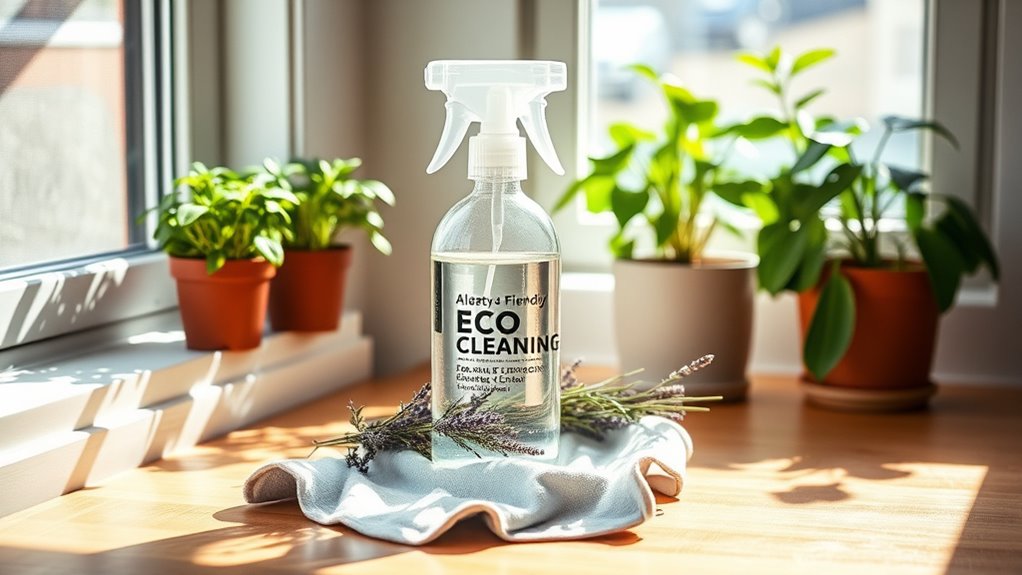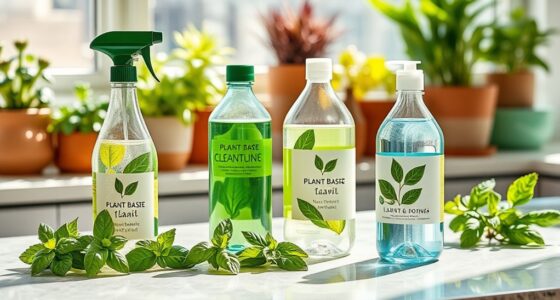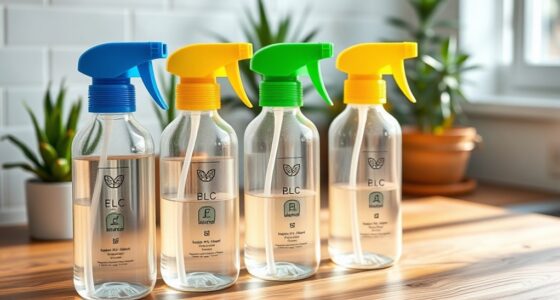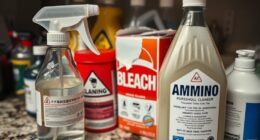To reduce VOCs and create a healthier home, opt for natural cleaning ingredients like vinegar, baking soda, and lemon juice, which emit fewer toxins than synthetic products. Choose eco-friendly, non-toxic cleaners, and avoid artificial fragrances and dyes. Ventilate your space during and after cleaning to help air out any lingering chemicals. Incorporating these simple, eco-conscious practices can make a big difference, and you’ll find more effective strategies as you explore further.
Key Takeaways
- Use natural cleaning ingredients like vinegar, baking soda, and lemon to reduce VOC emissions and chemical exposure.
- Select eco-friendly, non-toxic cleaning products free from synthetic fragrances and dyes to minimize indoor VOCs.
- Ventilate indoor spaces by opening windows and doors during and after cleaning to dissipate VOCs effectively.
- Regularly dust and vacuum with HEPA filters to decrease dust, allergens, and VOCs trapped in indoor air.
- Maintain low humidity levels to prevent mold growth, which can contribute to indoor air pollutants and VOCs.
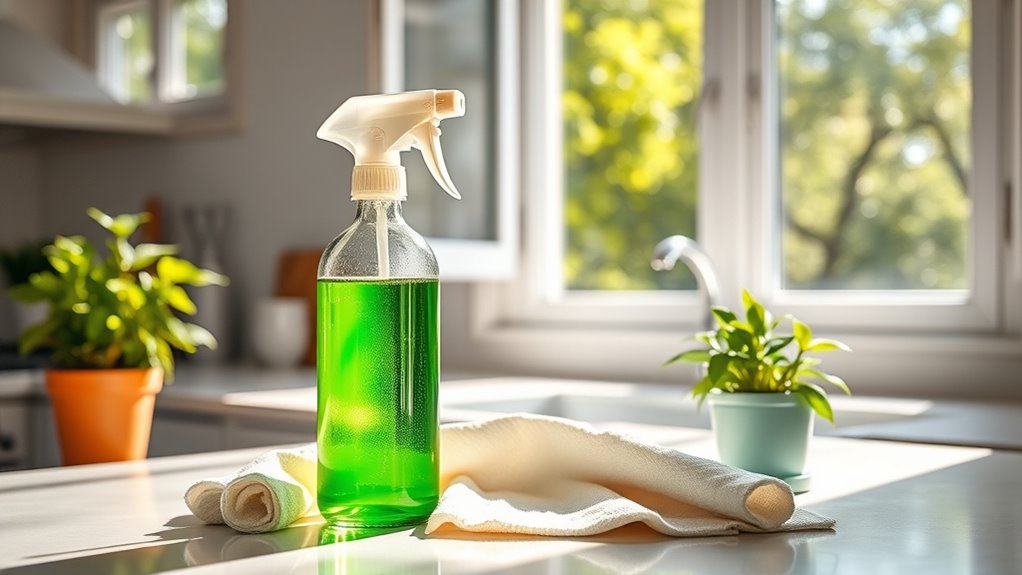
If you suffer from allergies, choosing eco-friendly cleaning methods can make a vital difference in reducing irritants in your home. One effective way to lower airborne irritants and VOCs (volatile organic compounds) is by using air purifiers. These devices help filter out dust, pet dander, pollen, and other allergens that can aggravate allergy symptoms. When selecting an air purifier, look for models with HEPA filters, which are proven to trap tiny particles that standard filters often miss. Some air purifiers also incorporate activated carbon filters, which can absorb certain VOCs, further improving indoor air quality. Using an air purifier consistently, especially in bedrooms and living areas, can greatly reduce allergen levels and create a healthier environment.
Using HEPA and activated carbon filters in air purifiers reduces allergens and VOCs for a healthier home environment.
Alongside air purifiers, switching to cleaning products made from natural ingredients is vital for allergy sufferers. Conventional cleaners often contain harsh chemicals and synthetic fragrances that release VOCs into the air, worsening allergy symptoms and causing respiratory irritation. Instead, opt for natural ingredients like vinegar, baking soda, lemon juice, and essential oils. These ingredients are effective cleaners and emit fewer airborne toxins. For example, a mixture of vinegar and water works well for cleaning glass and countertops, while baking soda can deodorize carpets and remove stains. Lemon juice adds a fresh scent and has natural antibacterial properties. Using these natural ingredients not only reduces VOCs but also minimizes the chemical exposure that can trigger allergies.
When cleaning, make sure to ventilate your home by opening windows and doors to allow fresh air to circulate. This helps disperse any airborne particles or VOCs released during cleaning. Always read labels carefully to make certain your cleaning products are truly eco-friendly and free from added synthetic fragrances or dyes. If possible, choose products labeled as organic or non-toxic, which are designed to emit fewer irritants. Incorporating air purifier technology into your routine can further enhance your home’s air quality and allergy relief efforts.
Incorporating air purifiers and natural ingredients into your cleaning routine creates a safer, allergen-reduced environment. Regularly dust and vacuum with HEPA-filtered equipment, and keep humidity levels low to prevent mold growth. These simple steps can greatly alleviate allergy symptoms and contribute to a healthier home. Remember, consistency is key—small, eco-friendly changes can have a big impact on your indoor air quality and overall comfort.
Frequently Asked Questions
Are Natural Cleaning Products Always Safe for Allergy Sufferers?
Natural cleaning products aren’t always safe for allergy sufferers because they can still contain synthetic fragrances and chemical preservatives that trigger reactions. You should carefully read labels and choose products labeled as fragrance-free or allergy-friendly. Even natural ingredients like essential oils can cause sensitivities. Always test a small area first and consult with your doctor if you’re unsure about specific ingredients. Staying vigilant helps you clean safely without aggravating allergies.
How Can I Identify Hidden VOC Sources in My Home?
Think of your home as a treasure hunt, where hidden chemical sources lurk like buried clues. To spot allergen hiding spots, check behind furniture, inside cabinets, and under sinks, as these often trap VOCs. Read labels carefully on cleaning supplies, air fresheners, and scented candles—these are common hidden chemical sources. Ventilate rooms regularly to flush out airborne VOCs, and consider using an air purifier to detect and reduce unseen VOCs.
Do Air Purifiers Reduce VOC Levels Effectively?
Air purifiers can effectively reduce VOC levels if they have high-efficiency filters like activated carbon or HEPA filters designed for VOC removal. Their efficiency depends on the purifier’s quality, size, and placement within your home. To maximize VOC reduction, choose an air purifier specifically rated for VOC removal, run it continuously, and keep filters clean. This way, you’ll improve indoor air quality and lessen allergy triggers.
Can Homemade Cleaning Solutions Eliminate Allergens Without VOCS?
Yes, homemade cleaning solutions can help eliminate allergens without VOCs. By using DIY solutions like vinegar, baking soda, and lemon juice, you avoid chemical concerns associated with commercial cleaners. These natural ingredients effectively break down dirt, mold, and dust mites, reducing allergen buildup. Plus, they’re safe for your family and the environment. Just make certain you use proper ratios and test surfaces first to avoid any potential damage.
How Often Should I Ventilate My Home During Cleaning?
You should ventilate your home during cleaning at least 15 minutes after you finish, but don’t stop there. Regularly open windows during the day, especially during ideal airing times like mornings or late afternoons, to keep VOC levels low. Ventilation frequency depends on your cleaning routine, but consistent airing helps prevent allergen buildup and improves indoor air quality. Stay vigilant—fresh air is your best defense against airborne irritants.
Conclusion
Remember, a clean home is a happy home, especially when you’re sensitive to allergens. By choosing green cleaning products and minimizing VOCs, you create a healthier environment for yourself and your loved ones. Stick to your routine and stay vigilant—small changes can make a big difference. As the saying goes, “An ounce of prevention is worth a pound of cure.” Keep these tips in mind, and enjoy a fresher, safer living space every day.
